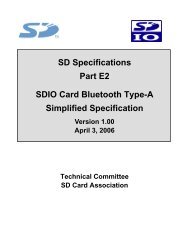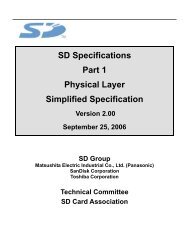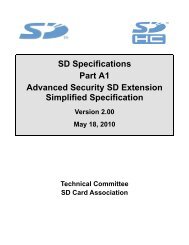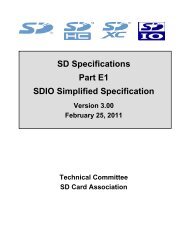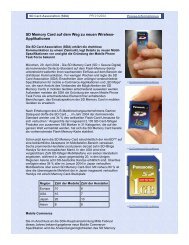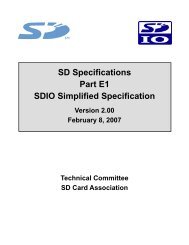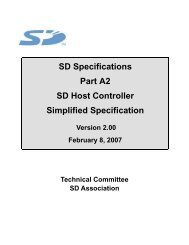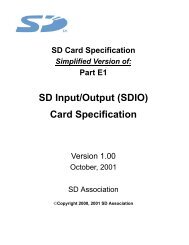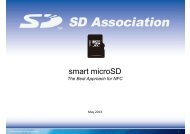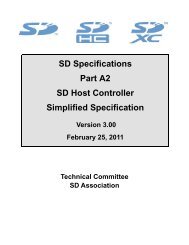SD Specifications Part 1 UHS-II Simplified Addendum - SD Association
SD Specifications Part 1 UHS-II Simplified Addendum - SD Association
SD Specifications Part 1 UHS-II Simplified Addendum - SD Association
You also want an ePaper? Increase the reach of your titles
YUMPU automatically turns print PDFs into web optimized ePapers that Google loves.
<strong>UHS</strong>-<strong>II</strong> <strong>Simplified</strong> <strong>Addendum</strong> Version 1.01©Copyright 2010-2013 <strong>SD</strong> Card <strong>Association</strong> Mechanical layer defines mechanical specification such as card form factor, connector pins andso on. Physical layer (denoted by PHY) defines electrical specification such as signaling architecture,and handle bit or symbol encoding and decoding. Link layer (denoted by LINK) is responsible for Link management including PHY initialization,and data integrity (packet framing / de-framing and CRC generation / checking). It is also in chargeof power management and flow control. Transaction layer (denoted by TRAN) is responsible for protocol-base management includingpacket generation and analysis, command-response handshake, and so on.TRAN is split into sub layers, one is a common layer called CM-TRAN and the other is an applicationspecific layer. CM-TRAN is responsible for Basic IO or Memory transaction and control. The applicationspecific layer bridges CM-TRAN and upper application layer in order to keep compatibility. <strong>SD</strong>-TRAN isone of the application specific layers and bridges CM-TRAN and Legacy <strong>SD</strong> applications or drivers.In this specification, <strong>SD</strong>-TRAN is also described. Other application specific layers can be defined in thefuture.3.3 <strong>UHS</strong>-<strong>II</strong> Transaction3.3.1 <strong>UHS</strong>-<strong>II</strong> PacketThe following five packet types are defined for <strong>UHS</strong>-<strong>II</strong> TRAN. <strong>UHS</strong>-<strong>II</strong> Packet other than MSG is alsocalled Transaction Layer Packet (TLP). Control command packet (denoted by CCMD) is a command without Data packet transaction.There are two categories of CCMD, one is P2P CCMD and the other is broadcast CCMD. Refer toSection 6.2.2.3 for the details of them. Data command packet (denoted by DCMD) is a command accompanied with Data packet. Response packet (denoted by RES) is a response that Device returns to Host after receivingCCMD or DCMD. Data packet (denoted by DATA) is for transmitting data payload between Host and Device. Message packet (denoted by MSG) is for transmitting short information. Only MSG is generatedor analyzed in LINK.Basically, <strong>UHS</strong>-<strong>II</strong> packet consists the following three parts, Header, Argument, and Payload. The Headerpart is common for all types of packet.TLP is basically packetized based on information provided by TRAN and depacketized in LINK. Refer topacket format described in Section 6.2.2 or Section 7.2.1 for the details of the information.Let initiator denote a Node (Host or Device) that newly creates a packet and transmits it. The followingtable indicates the initiator for each packet type.Packet TypeCCMD/DCMDRE<strong>SD</strong>ATAMSGInitiatorHost (regardless of P2P CMD or broadcast CMD)DeviceNode creating DATA packet(Host for write transaction, Device for read transaction)Node creating MSG packetTable 3-1 : Definition of Initiator8



